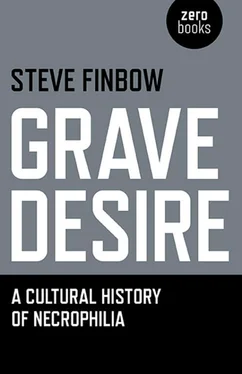Norman Bates and Leatherface are monstrous realizations of our own repressive desires and, concurrently, manifestations of oppressive economic transferences of otherness. In The Texas Chain Saw Massacre, [134] For a further analysis of The Texas Chain Saw massacre, see Robin Wood, ‘An Introduction to the American Horror Film’, Planks of Reason: Essays on the Horror Film, Barry Keith Grant, ed. (Metuchen, NJ, 1984); and Naomi Merritt, ‘Cannibalistic Capitalism and other American Delicacies: A Bataillean Taste of The Texas Chain Saw Massacre,’ Film-Philosophy, Vol. 14, No. 1 (2010).
the two couples are split up (literally and viscerally in one case), their sexual and potentially familial normality sundered. Leatherface’s ‘family,’ ostensibly driven to cannibalism by the mechanical automation of the slaughter-house—their ‘otherness’ played out in their unemployment and their necrophagy—threaten the status quo, threaten the perception of the human in its emancipated desires. Both monsters—Norman and Leatherface (and Bertrand by association)—represent their particular culture in crisis. All attempt to annihilate women from their twisted all-male families, or Bertrand’s military substitute. Bates, Leatherface, and Bertrand deny the human, deny the possibilities of normality, of capitalist society, and of reproduction.
For Bates, Leatherface, and Bertrand, the society (and family) they resided in was under threat from outside sources—Communism, America’s defeat in Vietnam, revolutionary France. They react to this rupture by living transgressive versions of the family (society’s minimalist mirror) as an animadversion of the existing culture and status quo. The family as reproductive unit—re-upping workers for capitalism’s existence, re-supplying subjects of its oppressive/repressive hegemony and ontology—becomes subverted by the assimilation of taboo as moral standard. An increase in capitalist productivity—what I will call object-productivity—means a deterritorialization of the worker from the workplace—Norman’s unvisited motel as pleasure-principle prosthesis, Leatherface’s dream/nightmare house of cannibalistic production, Bertrand as inverted agent of capitalist power, Grossmann, Denke, Haarmann, and Kürten’s unemployment and/or work as butchers. (In their occupation as soldiers and/or butchers, Bertrand and the others are employed in professions of suspended taboo.) Bates’s repressed sexuality and childlike innocence, Leatherface’s retardation and muteness, Bertrand’s obsession, the Weimar killers’ disenfranchisement, all point to an inherent otherness directly opposite normal social experience and behaviour. Bertrand’s transgression of taboo the more extreme as he—as a sergeant—embodies the protective agent of economic and political control. The transgressions of Bates, Leatherface, Bertrand, Kürten and co., evident in their relationships with animals—evisceration (Norman’s taxidermy), mutilation (Bertrand’s pubescent experiments), bestiality (Kürten’s goats and sheep), object-productivity (the work of the butcher)—represent a break with taboo formation. Once taboos are instilled, humans separate from the animal; once transgressed, the transgressor makes a return to the animal—the unrestrained violence, the sex, the death. These transgressors commit necrophilia, necrophagy, and necrosadism as a means of reproducing the initial breaking of a taboo. Their means of production is death, a perverse anti-capitalism, an eroticism of entropy and annihilation.
The sound of grunting, metal in earth and on stone, the eroticized exertion of the exhumation, the black sheet of night covering the ingress until flashbulbs pornographize the bodies—close ups of deliquescing flesh, bones protruding through rotting skin, phallus penetrating vagina, phallic fingers and toes through vaginal mouths and eye sockets, the decomposing flesh wet as if oiled for lubrication. A human face, mouth open, teeth exposed—the agony and the ecstasy. These are close-ups of bodies dug from graves. A cemetery—in the middle, two exhumed bodies posed on a tombstone in sexual congress. At home in both Psycho and The Texas Chain Saw Massacre, the killer had preserved the body of a mother. Writers Robert Bloch and Thomas Harris, and directors Alfred Hitchcock, Tobe Hooper, and Jonathan Demme, used as their inspiration for Norman Bates, Leatherface (including his extended family), and Jame ‘Buffalo Bill’ Gumb, the true story of one of the twentieth century’s most infamous necrophiles—Ed Gein.
Jame ‘Buffalo Bill’ Gumb sits in the lip of a deep well in the basement of his house. At the bottom of the well, is a senator’s daughter—Catherine Martin—whom he has kidnapped. His plan is to starve her until her skin becomes loose, flay her and use her skin as part of a bodysuit in order to enact a sex change denied to him by the medical profession. ‘Jame Gumb: It rubs the lotion on its skin. It does this whenever it’s told.
Catherine: Mister, my family’ll pay cash. Whatever ransom you’re asking for, they’ll pay it. Jame Gumb: It rubs the lotion on its skin or else it gets the hose again. (DOG BARKS) Yes, it will, Precious. It will get the hose.’ [135] The Silence of the Lambs, dir. Jonathan Demme, 1991. Author transcription.
Three years after the release of The Silence of the Lambs, in the English town of Gloucester, police arrested Fred West on the suspicion of kidnap and murder, eventually charging him and his wife Rose with 12 and 10 murders respectively. The West’s used their victims as sex slaves before killing them. In Happy Like Murderers, Gordon Burn writes, ‘All through his [Fred’s] life he would invest his deepest and most complicated emotions—all his most difficult and disturbing thoughts—not in people, but in things. Places and things. People as things. He always preferred inanimate objects to breathing, responding—and therefore threateningly dangerous and unpredictable—people. The deadened and dehumanized over the alive and responding. That would be his choice every time.’ [136] Gordon Burn, Happy Like Murderers (London, 1999), pp. 105-06.
Dehumanization, the reduction of the human to the thing, the it, the sex tool, the utensil, an ontic nullity that may be either machine-like—Gumb, West and Gein—or fetishistic—West and Gein. To Gumb, animals are ‘Precious’ (the name of his poodle), yet human beings are ‘its’; for West, tools had personal pronouns—she, he, while humans became ‘its’. For Gein, humans became tools, decorations, furniture. Gumb transforms humans into tools for gender reassignment, West turned them into paralyzed sex machines, while Gein made humans into representations of his dead mother and into kitchen utensils. Bertrand viewed humans as organs devoid of any human system—the dead bodies are anti-locomotive, anti-nutritious, and anti-reproductive. West found it difficult to get an erection unless surrounded by tools—hammers, knives, wrenches; Bertrand and Gein had to reduce the ‘other’ to a ‘thing,’ to a tool. ‘Things themselves are actants—not signifieds, phenomena, or tools for human praxis… Once things are reduced to nothing, they beg you to be conscious of them and to colonize them. Their life hangs by nothing more than a thread, the thread of your attention… Without you the “world,” as you put it, would be reduced to nothing.’ [137] Graham Harman, Prince of Networks: Bruno Latour and Metaphysics, (Melbourne, 2009), p. 24.
West and Gein’s murder victims and Bertrand and Gein’s exhumed bodies become actants in the consciousness of and colonization by their violent others. Before they become a (dead) signified, a phenomena, a tool for human sexual praxis, they give their existence, their being, to the violent other. In The Texas Chain Saw Massacre, Sally Hardesty begs the family not to kill her, saying, ‘Please, I’ll do anything… anything you want.’ Sally will do anything. After being bound, gagged, subjected to sexual violence by Rose and Fred West, and then raped by Fred when Rose leaves the room, Caroline Raine promised not to tell Rose in exchange for her life. Fred agreed and Caroline joined the Wests for the rest of the day, looking after the children, going to the laundrette, before making her escape. From sex slave to economic slave, the women became things of barter, their bodies used in an erotic economics of ontological exchange—a translation of being for existing.
Читать дальше












